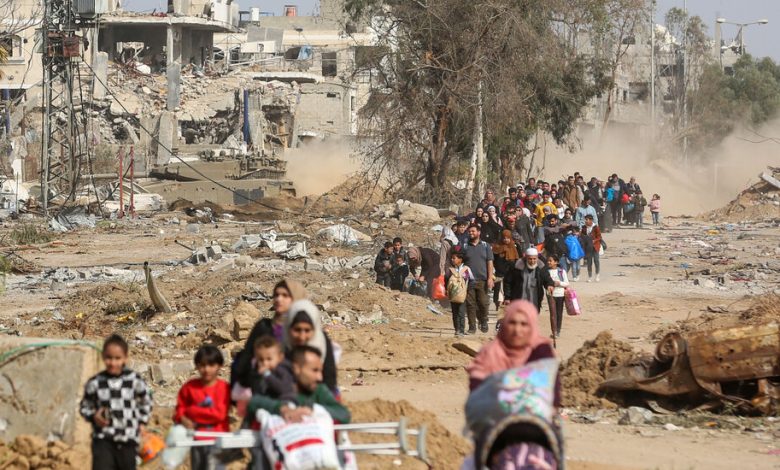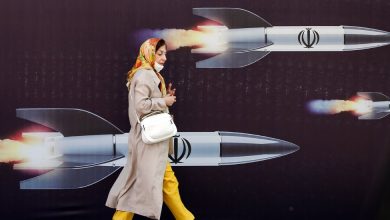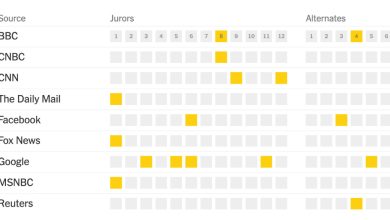Fearful, Humiliated and Desperate: Gazans Heading South Face Horrors

They walked for hours, raising their hands when they encountered Israeli troops with guns trained on them to display their I.D. cards — or wave white rags. All around them was the sound of gunfire and the incessant buzzing of drones. Bodies littered rubble-filled streets.
For the tens of thousands of Gazans who have fled the northern part of the enclave where the heaviest fighting has been taking place, evacuating to the south has been a perilous journey, according to at least 10 Gazans that The New York Times spoke to on the ground and by phone. Even though a tenuous cease-fire in place since Friday has brought temporary relief from the bombardment, they face an uncertain future — and the threat the strikes will return, leaving them displaced yet again.
The Israeli military launched a deadly bombing campaign of the Gaza Strip after an attack on Israel by Hamas on Oct. 7 in which, Israeli officials say, 1,200 people were killed and 240 taken hostage. In the seven weeks since, Israel has pounded the tiny coastal enclave with the aim of destroying Hamas’s military capabilities. So far, more than 13,000 Palestinians have been killed as of Nov. 21, according to the Gazan health authorities.
For weeks, Israel has been urging Gazans living in northern towns to flee along Salah al-Din Street, the strip’s main north-south highway.

An Israeli soldier watches Palestinians evacuating south, from the window or a damaged house.Credit…Samar Abu Elouf for The New York Times
Those lucky enough or with means fled early, but some Gazans who spoke to the Times said they could not leave earlier because they do not have relatives or anyone they know in the south, cannot leave older family members behind or don’t have the resources. Instead, many sheltered in increasingly dangerous and desperate conditions at schools or hospitals in the north. But at some point, they made the difficult decision to leave.
Even that decision was fraught. In the weeks leading up to the cease-fire, Israel has also bombed the southern part of the Gaza Strip, and some Gazans feel uprooting themselves further with no guarantee of shelter in the south is not worth it.
The United Nations says 1.7 million of the 2.3 million residents in the Hamas-controlled enclave have been displaced.
The Gazans who spoke to the Times said they felt shame, loss of dignity and anger at finding themselves struggling for their lives in the latest war between Israel and Hamas. The journey — which takes Gazans hours depending on where in the north they are leaving from — is usually done on foot or on a donkey cart.
Aya Habboub, 23, remained in northern Gaza earlier this month, heavily pregnant with her third child. She gave birth in a hospital under intense bombardment but was forced to evacuate when the baby, whom she named Tia, was just four days old.
Barely able to walk, Ms. Habboub tried to rest by the side of the road, but her husband urged her to keep going. Israeli soldiers, she said, stopped her mother-in-law and ordered the woman to stand for half an hour and raise her hands.
“Then they were firing,” Ms. Habboub said, “and we started running.” Ms. Habboub was speaking in a hospital in Deir al-Balah, a city in central Gaza, where many are sheltering. In her lap, Tia, cocooned in a white cloth, was sleeping peacefully.
“I dropped my baby,” she said. “I was crying and screaming.”
Several Gazans whom the Times spoke to described similar scenes of soldiers firing in the general vicinity of those fleeing. It was not possible to verify independently such claims.
The Israel Defense Forces did not comment on the specific allegations. In a statement responding to questions about them, the military said it had taken “significant precautions to mitigate civilian harm.” It added that it had issued warnings of airstrikes ahead of time, when it can do so, and told civilians when to make use of “safe corridors” to evacuate.
It reiterated its assertion that Hamas has embedded itself within “civilian infrastructure and uses civilians as human shields. “The I.D.F. is determined to end these attacks, and as such we will strike Hamas wherever necessary,” it said.
In the few days since a temporary truce between Israel and Hamas took hold, some Gazans have continued moving south. Others have tried to return north to check on loved ones and their homes, but Israeli troops have prevented that.
Mohammed El-Sabti said he began a trek from the Zeitoun neighborhood in Gaza City on a recent morning with 15 family members, including his elderly mother. He saw another older woman screaming by the side of the road. She begged him for help, but Mr. El-Sabti was struggling with the load he was already carrying while he pushed his mother on a cart.
Mr. El-Sabti, who is now sheltering at a college building in the southern city of Khan Younis, rejected Israeli assertions about the safety of the so-called humanitarian corridor that Gazans are being urged to use to flee from the north.
“The corridor is not humanitarian, and it’s unsafe,” he said. “It’s an area of horror.”
After weeks of enduring intense airstrikes, smelling corpses and losing their homes and relatives, they speak with numbness about the horrors they’ve witnessed in their hometowns and on the road south.
“I had two boys and five girls,” said Malak El-Najjar, 52, who used to live in the Mukhabarat area in Gaza City and is now sheltering in Khan Younis. “Two of the girls are dead,” killed in an airstrike before they left, she said, aged 18 and 20.
Iman Abu Halima, 33, who first fled from Beit Lahiya in the north before taking shelter temporarily in Jabaliya and then carrying on south after it got too dangerous, described seeing “bloated bodies, flies on them,” next to scattered body parts.
“We saw many dead bodies,” said Mazen Abu Habil, a 52-year-old father of eight, who eventually made it to Khan Younis, which has become a teeming place of refuge for displaced people. There, Gazans cram into hospitals and U.N. shelters, living in substandard conditions — chasing a meal a day, sleeping with barely any blankets, wearing the clothes they fled with.
Mr. Abu Habil used to live in Jabaliya, a neighborhood north of Gaza City that Israel says is a Hamas stronghold and has been pummeling with airstrikes. He fled to Al-Shifa Hospital in Gaza City once his house was destroyed, and then, when it was no longer safe there, to Nasser Hospital in Khan Younis. Israel has recently produced video and photographs that it says shows Al-Shifa, a sprawling complex, conceals an underground military base used by Hamas. The militant group has denied it is operating from beneath the hospital.
“I saw a little girl who was killed on the ground,” Mr. Abu Habil said. With an eye on Israeli soldiers patrolling nearby, he said, he tried to cover the girl with a small cloth. “As I did that, they suddenly started shooting,” he said.
He described how the Israeli soldiers, many of whom spoke in Arabic, ordered him to undress and detained him for about 90 minutes. Eventually they let him go.
But that was not the case for everyone. Zahwa Al-Sammouni, 58, said she was fleeing south with her family when Israeli soldiers detained her three sons, all of them young men.
“What can we do?” Ms. Al-Sammouni said. “We’re too scared to yell or cry. We just want to know where did our kids go?”
She added: “We are farmers, we have nothing to do with weapons, with Hamas or with Fatah.” She added: “We are just looking for a piece of food because we have children to feed.”
She was squatting at the hospital in Deir El-Balah with more than a dozen members of her extended family.
Ms. Al-Sammouni and the people with her spoke in a stream of consciousness, recalling harrowing details of their journey. They talked about Israeli troops yelling profanities at them; about how the chaos of Gaza had become a matter of survival of the fittest in which people’s humanity extended only to immediate families; about desperately searching for even salty water to drink.
Some Gazans’ journeys had several false starts. Hamada Abu Shaaban, 33, a foreign exchange trader, fled on foot after Israeli strikes hit near his home in Gaza City. With his mother and aunt, and a suitcase full of cash, he began his journey, before clashes broke out. Mr. Abu Shaaban and his family hid for 16 hours in a nearby garage until the violence subsided. They managed to get home and tried again the next day. It was not easy.
“I do not understand how I went through all of these scenes without losing my mind,” he said in Al Maghazi, a community built up from a refugee camp established decades ago, in central Gaza.
Imad Ziyadeh, who fled south to Khan Younis from near Beit Lahia, described his journey as one of “suffering, torture, terrifying fear.”
He said people were able to take the barest minimum of possessions: clothes, identification cards and the rags they used as white flags.
Israeli soldiers, he said, yelled at them constantly. And on the road were horrific scenes. “Bodies all around us,” he said. “You look to the right, you see body parts.”
The comparison to the Nakba, or the displacement of Palestinians during the wars surrounding the founding of Israel, were not far from people’s minds, he said. “In 1948, we were displaced, and now in 2023 we are being subjected to a forced displacement,” Mr. Ziyadeh said. “I’m not expecting to go back to north Gaza, but if they do make us go back, what will we go back to?”
Abu Bakr Bashir contributed reporting from London, and Samar Hazboun from Bethlehem, the West Bank.



